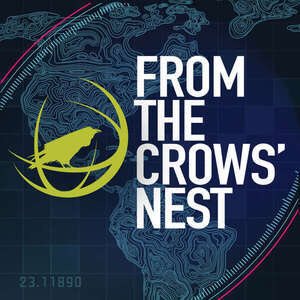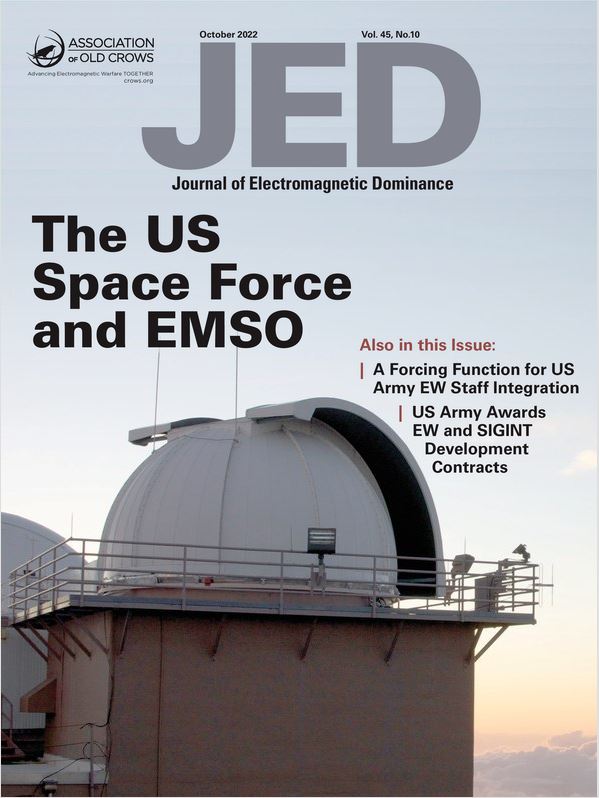.png) |
||||||||||||||||||||||||||||||||||||||||
| Archive | Subscribe | Crows.org | JED Resource Guide | WWW.JEDONLINE.COM | ||||||||||||||||||||||||||||||||||||||||
|
From the Editor
Wednesday Theme: Young Crows Today's theme at AOC 2022 is Young Crows. As we think about these members of our community, it's important to avoid classification based on age. Young Crows aren't like us or similar to us — they are us. They are beginning their careers – in uniform, as part of academia and as industry professionals. What do Young Crows value in our community? Mentorship? Responsibility? Gaining experience? Where and when do we begin to attract Young Crows to our profession? How does our community create rich and rewarding career paths for Young Crows? These Young Crows share with us the same enthusiasm, the same curiosity and the same sense of mission and duty. How do we help them soar? Visit the Convention website or download the app to learn more. In this special episode of From the Crows’ Nest recorded from AOC 2022 in Washington, DC, host Ken Miller is joined by guest John Knowles, Editor-in-Chief of the Journal of Electromagnetic Dominance (JED), the AOC’s official publication. Ken and John talk about the concept of an Electromagnetic Spectrum Operations (EMSO) playbook and what it means for stakeholders across military and industry, both in the US and abroad. They also discuss how to best apply lessons from the playbook to the dynamic global threat environment, including both Russia’s invasion of Ukraine and growing tensions in the Pacific. To learn more about today’s topics or to stay updated on EMSO and EW developments, visit our homepage.
Symposium Happenings
The AOC 2022 Symposium kicked off Tuesday morning with a keynote address from Gen. Chris Badia, German Air Force, who spoke from his perspective as NATO's Deputy Supreme Allied Commander, Transformation. Allied Command, Transformation is one of NATO's two strategic commands. Here are some of the main points from his speech. NATO's situation: Baida began by discussing what has changed and what NATO needs to accomplish. The main issue for NATO is that the security climate has changed. NATO is faced with global power competition from China and Russia. Baida also says that conflicts are stretching longer – more than 10 years for places such as Libya, Mali, Syria and Iraq and eight years for Ukraine. He explains that NATO focused for too long on asymmetric threats and terrorism. While Russia and China developed UAVs and hypersonic weapons, NATO did not invest much in game-changing weapons. MDO and EMO: Badia says, the Alliance has long understood the important role of protection of our forces and allowing access to the electromatic environment. He described NATO's approach to Multi-Domain Operations (MDO) and Electromagnetic Operations (EMO). MDO, he said, is an end-state and not a capability. It requires synchronization across all five warfighitng domains – air, land, sea, space and cyberspace. EMO cuts across all five domains, as well. One of NATO goals is to integrate MDO and EMO. The second speaker of the morning was Margaret Palmieri, Deputy Chief Digital AI Officer, Chief Digital and Artificial Intelligence Office (CDAO). Coming to CDAO from her prior role as Director of the Navy Digital Warfare Office, she began with a brief overview of the Navy's efforts to develop network and information warfare concepts over the past 10-20 years, spanning from the early days of NIFC-CA to its current concept of Information Warfare. She said the Navy's concept of Electromagnetic Maneuver Warfare in the 2012-15 timeframe had a significant influence on its later Distributed Maritime Operations concept. "That DMO concept was about distributed forces integrating effects and maneuver in the electromagnetic spectrum over space and time and bringing together kinetic and non-kinetic capabilities." Palmieri moved on to talk about her current role at CDAO. She said the CDAO is charged with accelerating the adoption of AI throughout the DOD. One of its focus areas is identifying and removing barriers to AI adoption. "We get to be a demanding customer for the rest of the Department. So, if we run into a barrier somewhere – whether it's on the networks or infrastructure side, the compute side or the culture and concept side, we get to go after it. We fix it ourselves or work with partners to go fix it or elevate it up…. And that can't be underestimated." In the Q&A session, Palmieri was asked about AI and EW. She said EW is one of several AI hubs that CDAO has partnered with OUSD R&E to develop. At Tuesday’s spotlight session, panelists David Tremper, Director, Electronic Warfare (EW), Office of the Undersecretary of Defense (OUSD) for Acquisition and Sustainment; Logan Harr, Principal Director Integrated Sensing and Cyber, OUSD R&E; and Dr. Ken Plaks, Director, Adaptive Capabilities Office (ACO), DARPA, discussed the significance, challenges and opportunities with EMSO and EW across DOD operations, acquisition, advanced capabilities and S&T. Among the topics discussed, were: Creating interoperability: Military services are independently responsible for the acquisition of programs that fall below the acquisition category 1C. If there’s a common threat or joint capability need, each of the services will address it independently because there is no real system in place for them to easily exchange data, Tremper says. “Everything we tend to talk about in terms of spectrum capabilities is ambiguous to service,” he explained. “If a Service is going to acquire a capability, it’s in our best interest to figure out how we migrate the capability from one Service to the other so that all the services can benefit from the dollars invested.” Plaks added, “The fact that the Navy and the Air Force frequently can’t talk to each other is bad. We can fix it.” Practice vs play: Another challenge, Plaks says, is in testing vs real-world application. “There’s a huge leap from doing things in a lab and doing it in open air,” he says. “Being able to [test a system] indoors better than a lab but something less than the real world is something folks have gone after, I just think we need to crank it up to 11 and actually bring it to a much higher level.” Democratization of EW: “We’re past that inflection point, where commercial, off-the-shelf technology when it comes to digitizing the spectrum, being able to understand signals in the environment and what they mean — we’re now past the point where the DOD is driving that,” Harr says. The big challenge, Plaks says, is adapting to a world where, “for a couple thousand dollars, anybody can have a jammer.” Later, in the audience Q&A, he said, “…modern electronics is democratizing electronic warfare, for good or for bad.” Today's Events
SCHEDULE OF EVENTS - Wednesday, Oct. 26
Inside the Convention
Keynote Session: Today's keynote will be delivered by Mr. Chris O’Donnell, DASD, Platform and Weapon Portfolio Management OUSD, A&S; and VADM Kelly Aeschbach, Commander, Naval Information Forces, (NAVIFOR) Symposium Spotlight Session: Strategy Meets the Hill — This session examines the role of Congress in advancing electromagnetic warfare (EW) capabilities considering Russia's invasion of Ukraine and other emerging threats. Congress has the constitutional authority to provide oversight and funding for US national defense. This includes sustainably funding EMS capabilities, training, and force integration across to strengthen the Department of Defense's (DoD) ability to achieve and sustain EMS superiority. This expert panel will look at how Congress addresses EMS operations through its annual National Defense Authorization Act and Defense Appropriations processes. Symposium Breakout Sessions: Supply Chain — General Eisenhower famously stated, “Plans are worthless, planning is everything.” Nothing could be truer today than when a lack of material in the supply chain forces government and industry leaders to rebuild their plan daily. The panel will cover key domestic dependencies of the supply chain, i.e. microelectronics, and the foundational access to materials which support our EMSO systems. The U.S. has a unique lead in some of these technologies, such as GaN for DE systems, while others are global commodities. Additionally, the panel will discuss how visionary development methods such as digital engineering are flowing down to partners and suppliers, expediting the delivery of new systems. Standards & MOSA — This panel will discuss the Open Architecture ecosystem: how different standard bodies are governed, how to get involved, and how to ensure conformance with the standard to meet the ultimate expectation of improved performance, schedule, cost, modularity, upgradability, sustainability, and ultimately improved warfighting capabilities. The panel will include advanced standards that support Cognitive EW. Unmanned/Uncrewed Systems — Uncrewed systems require different technology under the hood to make real-time decisions instead of depending on operators. What does an uncrewed system need to return from a mission to enable a “debrief?” Does reprogramming change in this new world? How does AI & ML impact the operations of the EMSO systems on these platforms? Program Manager Briefing Series: Army Programs and Air Force AOC Assembly of Delegates: AOC Awards Presentation Special Session: Young Engineer Panel More details are available from our symposium agenda.
Exhibitor Happenings
Official Exhibit Hall hours during the AOC Convention are as follows: Today Thursday, Oct. 27 Learn more about exhibitor happenings and special events on the AOC Convention's Exhibit Hall Hours & Happenings page.
JED News
Cover Story: The US Space Force and EMSO News: US Army Awards EW and SIGNIT Development Contracts Start reading the issue now, and read more each week at jedonline.com The Journal of Electromagnetic Dominance (JED) is the official publication of the Association of Old Crows (AOC), an independent, nonprofit, international professional association promoting public understanding in the science and practice of EW, SIGINT and related disciplines. Become an AOC member to get access to the latest issue of JED. Spotlight Q&A John Serafini, CEO of HawkEye 360, has over a decade of experience investing in and leading national security oriented technology companies. John leads the company, which develops space-based radio frequency (RF) collection, mapping, and analytic capabilities. He previously served as Senior Vice President of Allied Minds, where he led the formation, financing and management of HawkEye 360, along with other Allied Minds companies such as BridgeSat, Federated Wireless, and Percipient Networks (WatchGuard acquired). A former Airborne Ranger-qualified US Army infantry officer, John is a graduate of the US Military Academy, Harvard Business School and the Harvard Kennedy School of Government. JED: Over the past year, HawkEye 360 has launched its fourth and fifth satellite clusters, with a sixth cluster scheduled for launch in December. How many satellites will the company have in orbit by the end of the year, and how will these last few launches improve RF geolocation coverage for customers? Serafini: So far this year, our satellites and their enhanced capabilities have quadrupled the amount of data we collect to help meet high commercial and government customer demand. With the number of satellites we have on orbit currently, we are able to collect data up to 16 times per day over key regions to provide a new layer of insight for users across the US government, allied governments and commercial and noncommercial partners. To read the rest of this interview at JEDonline, click here.
Digital Pub Bin
Check out current issues from our media partners. You'll also be able to find news coverage from throughout the week on the AOC Convention's News page. JED
|
||||||||||||||||||||||||||||||||||||||||








 The October issue of JED includes these highlights:
The October issue of JED includes these highlights: